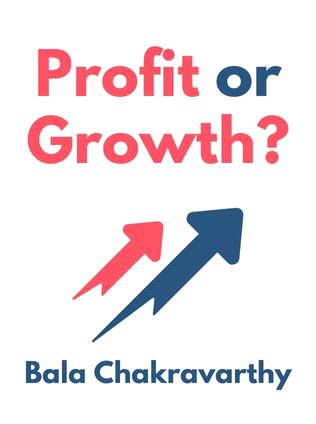
Profit or Growth?
Why You Don't Have to Choose
By Bala Chakravarthy,
Published 07/2007
About the Author
Bala Chakravarthy is a professor of strategy and international management at IMD, where he holds the Shell Chair in Sustainable Business Growth. His expertise spans business processes, corporate entrepreneurship, and managing organic growth. Peter Lorange is the president of IMD and holds the Nestle Professorship of International Business. His areas of expertise include strategy processes, joint ventures, and international strategy. Together, they bring a wealth of experience and research to the topic of achieving both growth and profitability in business.
Main Idea
The central theme of "Profit or Growth? Why You Don't Have to Choose" challenges the conventional wisdom that a firm must choose between sustained growth and strong profitability. Chakravarthy and Lorange argue that through continuous renewal, firms can achieve both. This requires a balanced strategy that leverages organic growth, alliances, and acquisitions, all orchestrated by senior executives who play a pivotal role in setting the organizational context and driving renewal efforts.
Table of Contents
- The Performance Dilemmas
- Managing Performance Dilemmas
- The Simultaneous Pursuit
- A Question of Strategy
- Renewal-Oriented Managers
- Renewal Strategies
- Continuous Renewal
- Blended Approach
- The Entrepreneur-Manager
- Sponsoring Renewal
- Directing Renewal
The Performance Dilemmas
Many believe that profitability and growth are mutually supportive, the two elements of the holy grail of business success. However, research shows that over 40 percent of firms that achieved sustained profitability or growth failed to achieve the other. Instead of being mutually supportive, growth and profitability often present rival challenges. Sustaining growth can work against sustaining profitability, and vice versa.
"Both alternatives are equally valued; the unpleasantness lies in not giving one of the goals the attention it deserves." - Bala Chakravarthy
Managing Performance Dilemmas
Enhancing shareholder value requires managing twin dilemmas: driving growth and profitability while seeking both short- and long-term performance. No magic formula yields all four performance goals simultaneously. Firms often adopt a sequential approach, focusing first on profitability and then on growth. However, this approach can make balancing the two goals more challenging in the long run.
Systems and processes fine-tuned to maximize profitability cannot nurture entrepreneurship, while those geared towards growth often struggle with operational excellence. Therefore, firms should strive to balance both profitability and growth simultaneously, never losing momentum for either.
"Firms that have sustained both growth and profitability have, on average, achieved higher profitability and higher growth rates than firms that focused on one goal at the expense of the other." - Peter Lorange
The Simultaneous Pursuit
The idea is to continuously balance growth and profitability, ensuring that neither is neglected. Firms that manage to do this often achieve superior results. This balanced approach enhances both profitability and growth, creating a virtuous cycle of sustained performance.
A Question of Strategy
A persistent dilemma for leaders is to offer a strategy architecture that allows the firm to exploit existing opportunities while simultaneously exploring new ones. Winning today's competitive battles calls for investments that strengthen the firm's current capabilities and resources. Leaders should be prepared to cannibalize existing products, make core competencies obsolete, and retire unneeded resources to adapt to market changes.
Leaders must balance the exploitation of available markets and competencies with the exploration of new ones. This involves not just renovating current practices but also innovating to stake out new business domains for future growth.
Renewal-Oriented Managers
Successful continuous renewal requires managers who are adept at both optimizing current performance and driving strategic change. These managers, termed "entrepreneur-managers," must combine an external focus and risk-taking ability with operational discipline.
"Managers who have become good at optimizing performance under today's business model might be reluctant to try anything new." - Bala Chakravarthy
Renewal Strategies
The four essential renewal strategies are designed to ensure sustained profitable growth by balancing the need to exploit existing opportunities and explore new ones. These strategies are:
Sign up for FREE and get access to 1,400+ books summaries.
You May Also Like
Rich Dad Poor Dad
What the Rich Teach Their Kids About Money - That the Poor and Middle Class Do Not!
By Robert T. KiyosakiFreakonomics
A Rogue Economist Explores the Hidden Side of Everything
By Steven D. Levitt and Stephen J. DubnerThe Lean Startup
How Today's Entrepreneurs Use Continuous Innovation to Create Radically Successful Businesses
By Eric RiesWho Moved My Cheese?
An Amazing Way to Deal with Change in Your Work and in Your Life
By Spencer Johnson, M.D.Factfulness
Ten Reasons We're Wrong About the World – and Why Things Are Better Than You Think
By Hans RoslingMake Your Bed
Little Things That Can Change Your Life...And Maybe the World
By William H. McRaven



















